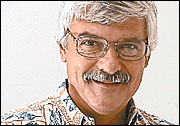


Capitol View
In Hawaiian political lore, no name is larger than that of Bob Oshiro, the self-effacing lawyer from Wahiawa, who now heads the multimillion-dollar Queen Emma Foundation, but for most of his life has been the Democrats' go-to man. Democrats owe
success to a guy
named BobFor 30 years, he was the Democrats' top strategist.
If he shied away from being called a kingmaker, his campaign plans were central to getting John A. Burns, George Ariyoshi and John Waihee elected governor.
Waihee's election, Oshiro said at the time, would be his last political campaign and while he has generally kept out of election politics, leaving it to his son, state Rep. Marcus Oshiro, the political guru is still contributing.
In a series of interviews with the Center for Oral History at the University of Hawaii, Oshiro explained some of the nuts and bolts of how people come to be elected in Hawaii.
Money, for instance, is a much more subtly obtained commodity than first imagined.
Oshiro explained that in 1966 the cabinet officers for then-Governor Burns set up a special fund, like the old plantation days' tanamoshi fund, which everyone contributed to, but would be used for a set purpose.
"The idea here was that Jack can use it for his own personal needs, you know, for protocol or whatever reason. In 1969, they found out that Jack didn't spend a dime," Oshiro said.
So as the election neared, Oshiro was asked if he would run it full-time. They offered to pay him $3,000 a month.
"So from January of 1969, I was on it full-time. They used the tanamoshi fund, not the campaign fund, to compensate me," Oshiro said.
The important part of the story is what happened next. Instead of starting by giving orders, Oshiro spent six months quietly talking to people.
"I had to go into the field, so to speak, to find out what the thinking was. What was going on out there?
"I was talking to the people, talking to the community people, the grassroots people.
"I was surprised because there was a lot of misunderstanding," he said.
So in the middle of 1969 Oshiro set down the parameters for the campaign for the next year. At the same time he put together a political duo that has been electing Hawaii's governors for 30 years.
The media campaign, the TV ads, the booklets, radio commercials and newspaper ads, were handled by Jack Seigle. The media strategy was devised by international political consultant Joe Napolitan. They ran brilliant commercials, but Oshiro says that is not how you win a campaign in Hawaii.
"Quietly we worked our butts off at the grassroots level. I think we had about 30,000 plus throughout the state."
Those people started with Oshiro meeting one or two people at a time.
"To get them to believe again in the dream we had. So once you converse -- whether it's one, two, three or five people -- if you sell them in their heart without you telling them, they are messengers.
"That's how you get the numbers."
Oshiro went on to explain that as easy as it is to rely on the media, the campaign is actually won one on one -- over thousands of cups of coffee, with little ever really said, just a mutually arrived at understanding.
That is the essence of Hawaii politics. Those who get it assume that it is just the natural way to win, and those who can't see the carefully constructed winning formula are destined to keep advertising and campaign advisers rich while they remain unelected.
Richard Borreca reports on Hawaii's politics every Wednesday.
He can be reached by e-mail at rborreca@pixi.com